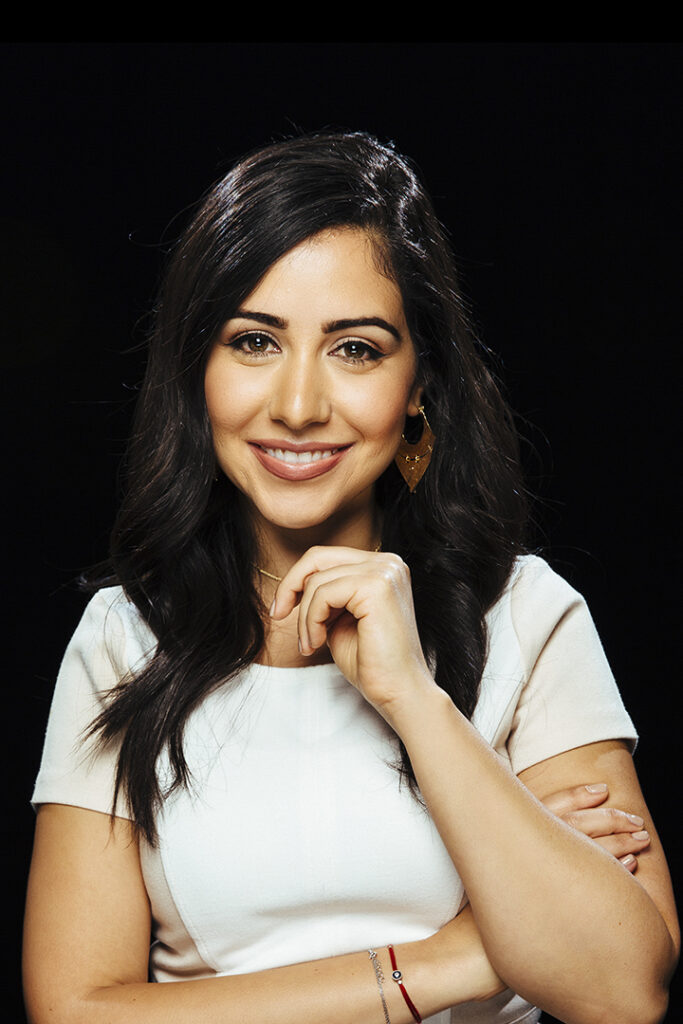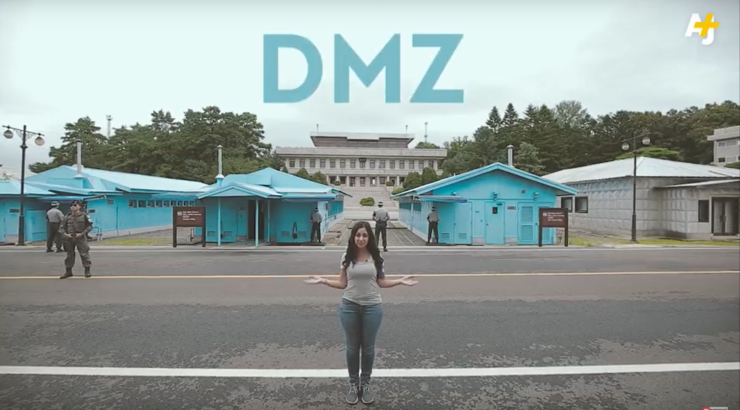For Dena Takruri, the power of journalism rests on its ability to give voice to the voiceless.
As a Muslim and Arab American, Takruri grew up watching the news and saw how underrepresented, and often misrepresented, people of color and marginalized communities really were.
“As a minority in America, you see how people are reported on and how they’re often dehumanized and not given their fair shake,” she says.
"I’ve always been upfront about my identity and background, and it’s shaped who I am and the lens through which I see other people’s struggles."
Now as a presenter at AJ+, a digital video news network that’s part of the Al Jazeera Media Network, she hosts her own YouTube series focused on sharing untold stories through field reporting. “Direct From with Dena Takruri” allows audiences see how people not just affected by policies and current events but living them, even as the camera rolls.
Coming into the reporting world at a time when new technologies have begun to change the face of journalism, Takruri has mastered the digital-first ideology. She was one of the first journalists to use Facebook Live as a reporting tool while covering the refugee crisis in Europe in September 2015.
With her huge social media presence (37,000 Twitter followers, more than 100,000 Facebook followers and hundreds of thousands of views on “Direct From” disptaches), Takruri has been able to meet news consumers at the source. And she says video, in particular, helps immerse audiences in current events.
“I think that ultimately creates a unique experience that allows you to understand an issue differently, have more empathy for those affected and feel like you're going on a journey of discovery with me, the correspondent,” she says.
I caught up with Takruri recently to talk about why she tackles underreported stories, what it means to be neutral as a journalist of color, and her experience as a woman on camera.

Where did you get your start in journalism?
My start in journalism was during grad school at Georgetown University. I was a co-host on a show on an Arab satellite channel called ART America hosted by young Arab Americans. That was my first onscreen job. I did my master’s in Arab studies, so I never actually studied journalism. Immediately after graduating, I was hired by Al Jazeera Arabic to be a producer on a weekly live current affairs talk show called Min Washington. Because I’m fluent in Arabic, it worked out really well. I produced that show out of Washington, D.C., for four years, then I moved to Huff Post Live in New York. Then I joined AJ+ four years ago.
What attracts you to places like North Korea and stories of refugees and Black Lives Matter activists?
Part of it is seeing how things are covered by mainstream news and identifying what’s missing. Oftentimes when people are talked about, they’re dehumanized, and you don’t really hear from them. It’s about amplifying the voice of the voiceless and giving them the platform to speak, seeing what’s missing from mainstream news coverage and wanting to correct that, or wanting to provide context that often goes unreported.
North Korea was just fascinating. My team will anticipate what we think is going to be a big story. With North Korea, we knew tensions were going to continue to mount, that Kim Jong Un and Donald Trump had been exchanging heated words early on. We decided we should go on the ground [in the DMZ between the two countries] and talk to folks there, anticipating a bigger story. My team and I always prioritize hearing from the people on the ground whose lives are at stake, be it the refugee crisis, Black Lives Matter or tensions on the Korean peninsula.
As an Arab and Muslim woman in America, what experience or perspective do you bring to your reporting and coverage?
I grew up watching the news a lot; my dad had the news on 24/7. As a minority in America, you see how people are reported on and how they’re often dehumanized and not given their fair shake. Seeing the really negative portrayal of Arabs, Muslims and Palestinians, which I also am, I wanted to correct that. Being part of communities that are marginalized, I understand what it means to be stripped of your humanity by mainstream news, by politicians.
Journalism is still a largely white profession. There’s a discussion going on in journalism right now about what it means to be neutral; for journalists of color this is an extremely complicated issue, as we saw with ESPN host Jemele Hill. Where does being a journalist end and being a person of color affected by policies that you have to cover begin?
I’ve always been upfront about my identity and background, and it’s shaped who I am and the lens through which I see other people’s struggles. I think it’s always important to be factual and fair to the topics and people you’re covering. But the question of objectivity is an interesting one. I was reading an article after Trump’s inauguration by a trans reporter, and they wrote, “I cannot be neutral or centrist about debates regarding my own humanity.” That’s how I feel. When this country wants to ban Muslims, and I am a Muslim American, there are certain values I’m not going to shy away from, and that’s equality for everybody. I’ve had Trump supporters scream in my face saying, “I don’t believe Muslims should be in this country,” looking straight at me knowing I’m a Muslim American. I’m comfortable speaking out about racism, bigotry, xenophobia. My identity as a woman of color shapes that, and it’s how I approach this. I think it’s been an asset. My identity and being open about it often creates trust with the people I’m reporting on [by] approaching subjects as a person of color who can empathize.
"As a minority in America, you see how people are reported on and how they’re often dehumanized and not given their fair shake. Seeing the really negative portrayal of Arabs, Muslims and Palestinians, which I also am, I wanted to correct that."
What’s been your experience being on camera as a woman with a large online presence?
That’s one of the most challenging parts. Regardless of how serious the reporting is, and how good the journalism is, I will always be seen as a woman. That means I’m subject to a lot of objectification and sexualization, and it’s very dehumanizing. One of my colleagues who does audience development and manages the YouTube channel has to constantly ban users because they’re commenting on the shape of my body and my appearance. Talking about a news video as if it was porn. It’s to the point where I’ve told my cameraman to only shoot me from the waist up. That’s really upsetting because you want to be judged by the quality of your work, not by your appearance. That’s something I’m constantly struggling to address. It really is a problem.
How do you prepare for an immersive reporting trip?
A lot of research, but it depends. If it’s a breaking news situation, you have to approach things as they unfold. With a four-part series on Korea recently on YouTube, we did a good amount of research ahead of that. We tried to really understand the history and U.S.-Korean relations, and understanding local politics and culture as much as possible. Not only am I doing the field reporting piece of that, oftentimes I’ll go live on Facebook or report on various social media platforms. [For that series], we started research about three weeks ahead of time. One [piece] was an interview with a North Korean defector. The meatiest piece was a look at the U.S. Army in South Korea that has had a permanent presence there since 1950, when the Korean War began. We visited the 8th Army, and their motto is “Ready to fight tonight.” We got access to go on the base. So that was one story: What does it mean to be ready to fight tonight?
What does video, and immersion reporting on video, offer to an audience?
I think people want to see the issues and stories covered on the ground. It’s one thing to do an explainer where you’re breaking down an issue; it’s another to be there experiencing it, talking to the people who have a stake in what’s going on. It builds trust with our audience. I’ve been on camera with AJ+ since day 1, and the audience got to see me doing these explainers. Now they actually see me on the field. To see me take them on a journey with me, I think the audience loves that. There’s no substitute for field reporting.
How much more immersive can you get than video? It allows someone to take in the scene and really understand the story in a new way. A lot of millennials get their news from video, so it's a matter of meeting them where they are in their social feeds and connecting to them that way. I think that ultimately creates a unique experience that allows you to understand an issue differently, have more empathy for those affected and feel like you're going on a journey of discovery with me, the correspondent.
Has social media changed your own work as a video journalist and presenter?
Social media has been amazing in that it’s allowed me to be super connected to my audience. I directly hear what they feel is underreported and want to see covered. That shaped a lot of the stories my team and I reported on, including Standing Rock, the refugee crisis, the Black Lives Matter movement, and the Native Hawaiian fight for sovereignty.
Also, social media has changed the way we actually create a video. I’m always mindful of the platform I’m producing for and try to optimize the content accordingly. A video that does well on Facebook has different requirements than one on that lives on YouTube or Twitter or Instagram, because people consume things differently on each platform. We’ve seen the Facebook feed be dominated by video over the last couple years. The conventional thinking at first was to keep videos as short and succinct as possible to cater to people’s shorter attention spans there, but I think as Facebook users are increasingly accustomed to seeing videos in their feed, they’re starting to favor higher-quality, longer pieces. The longer field pieces my team and I produce for the "Direct From with Dena Takruri” series have been well received as a result.



